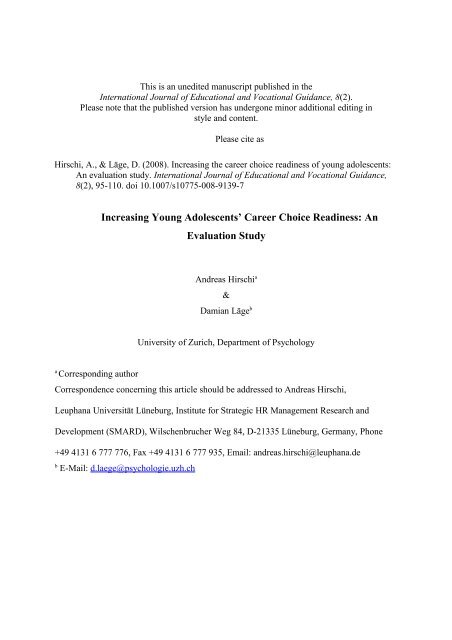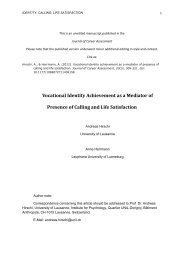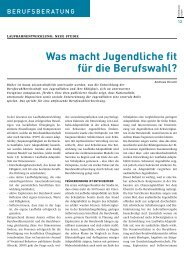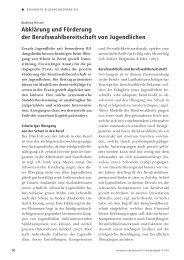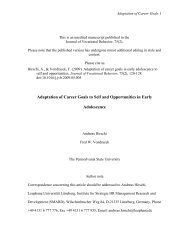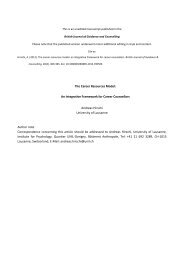Career Choice Readiness - Andreas Hirschi
Career Choice Readiness - Andreas Hirschi
Career Choice Readiness - Andreas Hirschi
Create successful ePaper yourself
Turn your PDF publications into a flip-book with our unique Google optimized e-Paper software.
This is an unedited manuscript published in theInternational Journal of Educational and Vocational Guidance, 8(2).Please note that the published version has undergone minor additional editing instyle and content.Please cite as<strong>Hirschi</strong>, A., & Läge, D. (2008). Increasing the career choice readiness of young adolescents:An evaluation study. International Journal of Educational and Vocational Guidance,8(2), 95-110. doi 10.1007/s10775-008-9139-7Increasing Young Adolescents’ <strong>Career</strong> <strong>Choice</strong> <strong>Readiness</strong>: AnEvaluation Study<strong>Andreas</strong> <strong>Hirschi</strong> a&Damian Läge bUniversity of Zurich, Department of PsychologyaCorresponding authorCorrespondence concerning this article should be addressed to <strong>Andreas</strong> <strong>Hirschi</strong>,Leuphana Universität Lüneburg, Institute for Strategic HR Management Research andDevelopment (SMARD), Wilschenbrucher Weg 84, D-21335 Lüneburg, Germany, Phone+49 4131 6 777 776, Fax +49 4131 6 777 935, Email: andreas.hirschi@leuphana.debE-Mail: d.laege@psychologie.uzh.ch
Increasing Young Adolescents’ <strong>Career</strong> <strong>Choice</strong> <strong>Readiness</strong> 2AbstractA career workshop to promote career choice readiness of young adolescents, applying modelsof the Cognitive Information Processing Approach (Sampson, Reardon, Peterson, & Lenz,2004) and incorporating critical ingredients (Brown & Ryan Krane, 2000) was developed andevaluated with 334 Swiss students in seventh grade applying a Solomon four group designwith a three-month follow-up. Participants significantly increased in career decidedness,career planning, career exploration, and vocational identity. Implications for evaluationresearch and counselling practice are presented.Keywords: career counselling, secondary students, career choice readiness, outcome research
Increasing Young Adolescents’ <strong>Career</strong> <strong>Choice</strong> <strong>Readiness</strong> 3Increasing Young Adolescents’ <strong>Career</strong> <strong>Choice</strong> <strong>Readiness</strong>: An Evaluation StudyChoosing a vocation can be regarded as one of the major developmental tasks inadolescence (Super, 1990). Within the Swiss educational system, two-third of the studentsstart a vocational education after mandatory school upon finishing the ninth. By the end ofgrade eight/beginning of grade nine, they have to apply for one of over 200 availablevocations. Each of them will train a student for two to four years in a specific occupation,where about two-third of the time is spent in a private apprenticeship firm and the rest invocational high-school (BBT, 2006). Each of these “choices” is circumscribed by a ratherrestrictive set of necessary scholastic aptitudes and other requested abilities and by theavailability of an occupation, ranging from 1 or 2 to over 1,000 firms offering apprenticeshipplaces within a given vocation in the larger region. In most regions, schools at the secondarylevel (grades 7 to 9) are divided among classes with advanced and basic requirements. Thishas also has an influence on the available options since certain vocations and general highschoolare only available to students from school classes with advanced requirements. Theone-third of students who do not start an apprenticeship continue to a general high-schoolhaving only minor specialisations available (e.g., slightly more mathematics or languagefocus) and are prepared for later college education with all available degrees possible topursue.The Swiss education system requires young adolescents to master a first challengingand influential career decision-making process at age 14 to 15, particularly during the eighthgrade. To support students in this task, a theoretically derived career intervention wasconceived for students near the end of grade seven to promote their career choice readinessand thus support positive development in the following career decision-making process ineighth grade. In accordance with Super (1990) we define career choice readiness as thereadiness and ability of a student to engage in the developmental task of career decision-
Increasing Young Adolescents’ <strong>Career</strong> <strong>Choice</strong> <strong>Readiness</strong> 4making and the school-to-work transition. The conceived intervention thus corresponds towhat Vondracek, Lerner, and Schulenberg (1983) called developmental intervention, with it’sfocus lying on optimization and prevention in developmental processes. The study is also inresponse to increased awareness of the importance of early and systematic support for asuccessful school-to-work transition in Switzerland (cf. EidgenössischesVolkswirtschaftsdepartement, 2005), as well as the demand for increasing the link betweentheory, practice, and accountability in career counselling on an international scale (cf. Herr,Cramer, & Niles, 2004). The intervention was also intended to be cost-efficient andapplicable to a wide range of students, hence corresponding to the increased attention toproductivity in career guidance (cf. Watts & Dent, 2006). Finally, the study addresses someshortcomings in the international counselling outcome research literature.<strong>Career</strong> Intervention Outcome ResearchDespite the fact that several evaluation studies for career interventions withadolescents have been published recently (e.g., Nota & Soresi, 2004; Repetto, 2001; Turner& Lapan, 2005), there is still a general need for rigorously conducted outcome studies toenrich the international literature (cf. Bernes, Bardick, & Orr, 2007). This seems especiallytrue since recent international reviews noticed a decline in published counselling evaluationresearch (Brown & McPartland, 2005; Whiston, Sexton, & Lasoff, 1998). An overview of theexisting studies (e.g., c.f. Brown & Ryan Krane, 2000) also reveals several shortcomings inthe current evaluation research which are addressed by the present study: (1) most studies areconducted with college students or more seldom college-bound high-school students. Studieswith young adolescents and non-college bound participants are rare; (2) most studies do notapply a follow-up to establish the long-term effects of the intervention; (3) the potentialinfluence of a pre-test on the outcome measures is hardly ever evaluated: (4) interventionswhich systematically incorporate findings from recent evaluation research in terms of critical
Increasing Young Adolescents’ <strong>Career</strong> <strong>Choice</strong> <strong>Readiness</strong> 5ingredients (Brown & Ryan Krane, 2000; Brown et al., 2003) have not yet been frequentlyconceived and evaluated; (5) the “Uniformity-Myth” (cf. Fretz, 1981) has still not beenbroadly challenged and most outcome studies do not evaluate possible differences ineffectiveness for different groups of participants.Present Study and HypothesesThe present study addresses each of the above mentioned issues by using young,mostly non-college bound adolescents as participants, conducting a follow-up measurement,evaluating the possible influence of a pre-test, evaluating an intervention whichsystematically incorporates recent meta-analytic findings, and analyzing possible differencesin effectiveness for different groups of students.Participants in the present study are distinguished regarding their gender, school-type,and nationality. There is research in Switzerland which indicates that these different groupsof students are also different in their career choice readiness development (<strong>Hirschi</strong> & Läge,2007) and that these three factors play a significant role in the school-to-work transition: malestudents, students from classes with advanced requirements and students with Swissnationality have better chances of obtaining an apprenticeship after school; even aftercontrolling for objective ability (Haeberlin, Imdorf, & Kronig, 2004). Since the workshopwas conceived as a generally applicable developmental intervention, it is consideredimportant that it is effective for different groups of students. Hence, these three influentialdemographic variables also seem important to consider in evaluating the differentialeffectiveness of the intervention.It is expected that the intervention can significantly increase the career choicereadiness of participants compared to a non-treatment control group immediately and at leastup to three months after the intervention. It is further assumed that the effects do not differ
Increasing Young Adolescents’ <strong>Career</strong> <strong>Choice</strong> <strong>Readiness</strong> 6regarding participants’ gender, attended school-type, or nationality. Finally, it is assumed thatthe pre-test does not have a significant influence on the outcome measures.MethodSubjectsParticipants were 368 secondary school students from 5 different schools and 16different school classes from a rural area in the German speaking part of Switzerland. At thetime of the pre-test, intervention, and post-test, participants were near the end of grade sevenand at the follow-up they were at the beginning of grade eight. 334 students (91 percent)participated on all three measurement points. They ranged from 12 to 16 years of age(M = 14.14, SD = 0.70). At the post-test, 6 students did not participate because they were notattending the school lesson when the data was collected. At the follow-up, 28 students did notparticipate, mainly because these students repeated one grade and were no longer in the sameclass as the study participants. These students do not differ on the four outcome measures atthe post-test from the remaining students (F(4, 351) = 0.829, p = .507 η 2 = .009). The finalsample of 334 students consisted of 156 students in the treatment group (32 percent withoutpre-test; 49 percent male; 63 percent advanced requirements, the other 37 percent basicrequirements; 82 percent Swiss, the other 17 percent other Nationalities, many from South-Eastern Europe) and 178 in the control group (23 percent without pre-test; 51 percent male;63 percent advanced requirements; 83 percent Swiss). The unequal distribution among thepre-test and no pre-test groups was intentional because some analyses could only beconducted with students who completed a pre-test (i.e., increase from pre-test to post-test), sothis group of students was designed to be as large as possible. The groups with and withoutpre-test do not significantly differ in their distribution of gender, school-type, or nationality.
Increasing Young Adolescents’ <strong>Career</strong> <strong>Choice</strong> <strong>Readiness</strong> 7MeasuresThe degree of career choice readiness was measured with four aspects. All scales arewell established measures in German language and were retrieved from official adaptationsof internationally well-known instruments. However, they are not strict translations of thesemeasures since empirical analyses of the respective authors during scale construction showedthat new items had to be conceived in order to reach satisfactory results in reliability andfactor structure. Thus, while the scales are supposed to measure the same constructs as theoriginals, no direct comparison on an item-level is possible.<strong>Career</strong> decidedness. The degree of decidedness and commitment in career decisionmakingwas measured with the respective scale of the German adaptation of the <strong>Career</strong>Maturity Inventory (Crites, 1973; Seifert & Stangl, 1986). The scale consists of 12 items(e.g. “I don’t know exactly what to do in order to choose the right occupation”) and answersare indicated on a four-point scale. In the present study, higher scores indicate more careerdecidedness. Studies could show that students with higher career decidedness on this measurealso show more overall career maturity, suffer less from stress in career decision-making, aremore active in applying for an apprenticeship after school, and are more successful inactually finding an apprenticeship (e.g., Bergmann, 1993; <strong>Hirschi</strong> & Werlen Lutz, 2007;Seifert, 1993; Seifert & Stangl, 1986). The reliability scores (Cronbach’s Alpha) for thepresent sample were .86, .86, and .87 for the three measurement points, respectively.<strong>Career</strong> planning. The degree of career planning was measured with the respectivescale from the German adaptation of the <strong>Career</strong> Development Inventory (Seifert & Eder,1985; Super, Thompson, Lindeman, Jordaan, & Myers, 1981). The scale consists of 22-itemstapping the amount of time and thoughts invested in career planning and answers areindicated on a five-point Likert scale with higher scores indicating more engagement incareer planning. Different studies showed that students with higher scores on this measure
Increasing Young Adolescents’ <strong>Career</strong> <strong>Choice</strong> <strong>Readiness</strong> 8also report more career knowledge and decidedness, are more likely to obtain anapprenticeship after school, and are more likely to realize their aspired major in university(e.g., Seifert, 1993; Seifert & Eder, 1985). Cronbach’s Alpha was .90, .90, and .88,respectively.<strong>Career</strong> exploration. The degree of career exploration was measured with therespective scale from the German adaptation of the <strong>Career</strong> Development Inventory (Seifert &Eder, 1985; Super et al., 1981). The scale asks students to indicate, whether they wouldconsult different sources of information for their career development (e.g. my father, myteacher, job-shadowing) and how much useful information they have already obtained fromthese sources. Answers are given on a five-point Likert scale with higher scores indicatingmore active career exploration. Studies showed the scale’s positive correlation with careerdecidedness, knowledge about the world of work, or success in finding an apprenticeship(e.g., <strong>Hirschi</strong> & Werlen Lutz, 2007; Seifert, 1993; Seifert & Eder, 1985). Reliability(Cronbach) was .85, .86, and .84 over the three measurement points, respectively.Vocational identity. To measure a student’s clarity of personal interests, strengths, andvalues, the German language adaptation of the Vocational Identity Scale (Holland, Daiger, &Power, 1980; Jörin, Stoll, Bergmann, & Eder, 2004) was applied. The scale consists of tenitems and answers were provided on a five-point Likert scale where higher scores indicate amore developed vocational identity. Studies show that the scale is positively associated withcareer decidedness, interest differentiation and congruence (<strong>Hirschi</strong> & Läge, 2007) and thatstudents with higher scores on this measure were also more likely to find an apprenticeshipafter school and were better able to realize their original career aspiration (<strong>Hirschi</strong> & WerlenLutz, 2007). Cronbach’s Alpha was .82, .85, and .86, respectively.
Increasing Young Adolescents’ <strong>Career</strong> <strong>Choice</strong> <strong>Readiness</strong> 9Procedure and Research DesignThe five participating schools were randomly assigned to the treatment (two schools)or the control group (three schools) using a quasi-experimental, non-equivalent groups design(cf. Heppner, Kivlighan, & Wampold, 1998). Although such a research design does notpermit as strong an internal validity as a randomized assignment of individuals, it isfrequently applied in field research because the groups already existed before the researchbegun. Students within the five schools were compared with MANOVAs taking the fouroutcome measures as dependent variables. The results of these analyses showed that nosignificant differences between the five schools exist at the pre-test on the outcome measures(F(16, 944) = 1.135; p = .317; η2 = .019).Schools and not single classes were chosen because we expected a greater acceptanceamong students and teachers to participate if their whole school would be treated equally inregards to the chance to receive the specific career intervention. Due to close collaborationwith the involved teachers, it was possible that all students from the selected treatmentclasses attended the intervention during regular school-time.The applied Solomon (1949) four-group repeated measures design with a three monthfollow-up used two treatment and two control groups. One of each completed a pre-test whilethe other two only completed the post-test and the follow-up. This research design allowsevaluating the influence of the pre-test independently of the treatment effect. Within thetreatment and the control group, two school classes were each randomly assigned to the nonpre-test groups.Three weeks prior to data collection, parents of all participating students wereinformed about the purpose of the study through a written statement. Students were thenadministered the questionnaires tapping career choice readiness and were asked to indicategender, school-type, and whether they have a Swiss or other nationality. Students assigned to
Increasing Young Adolescents’ <strong>Career</strong> <strong>Choice</strong> <strong>Readiness</strong> 11presents a model for the career decision-making process, the CASVE-Cycle, which providesa practical example of generic information processing in career decision-making. The cycledescribes successful career decision-making as consisting of five generic phases (1)Communication: “Knowing I need to make a choice”, (2) Analysis: ”Understanding myselfand my options”, (3) Synthesis: “Expanding and narrowing my list of occupations”, (4)Valuing: “Choosing an occupation”, and (5) Execution: “Implementing my choice”. Thecycle finally goes back to the Communication phase “Knowing I made a good choice”. Thesemodels lay the foundation for the content and process of the teaching modules and wereintroduced to the students as guiding principles for their own career decision-making process.Another major theoretical background for the intervention was the recent findingsfrom meta-analytic studies on career interventions effectiveness. Specifically, based on thefindings from Whiston, Brecheisen and Stephens (2003), a structured group workshop wasselected as treatment modality, since this seems to be “… the most empirically and costeffectiveinterventions for many clients” (Miller & Brown, 2005, p. 446). Also, the criticalingredients for effective career interventions as identified by Brown and Ryan Krane (2000;Brown et al., 2003) were systematically incorporated into the teaching modules as describedbelow.Intervention content. Nine teaching modules were conceived as presented in Table 1which were carried out consecutively. The first day started with module one and focused onintroducing the personal relevance of the upcoming career decision-making process for theparticipants and inviting them to reflect on their personal current state in the career decisionmakingprocess. Module two introduced the Pyramid of Information Processing Domains andthe CASVE cycle with practical examples as guidelines for their career decision-makingprocess. In module three, students undertook a brief self-assessment and conducted aninterview with one classmate regarding their interests and strength according to Holland’s
Increasing Young Adolescents’ <strong>Career</strong> <strong>Choice</strong> <strong>Readiness</strong> 12(1997) RIASEC typology. In module four, the counsellor gave the participants a briefoverview of the existing vocational and educational possibilities and invited them to askquestions about personally interesting options. Finally, the students received the smallhomework assignment that they should consult a website (www.berufsberatung.ch) for moredetailed information about their options and talk to their parents/guardians about the contentof the workshop and their personal career aspirations. On the next day of the workshop,within module five, students were invited to elaborate on personally interesting and suitablecareers/vocations with the help of their previously derived self-estimated RIASEC type and asimplified handbook of vocational codes. In module six the participants undertook astructured in-depth search about two of their most preferred vocational options with thematerials provided in the local career library and on the internet. Module seven then guidedthe students through a structured exercise to compare these two options regarding positiveand negative aspects for them and for important others. Module eight focused on helpingthem specify all available resources, both personal and organizational, which can supporttheir career decision-making process. They were also guided to make a written and specificplan about their next steps in the career decision-making process. The final module nine wasused as the closing session where the content of the whole workshop was reviewed.Based on the CIP Approach the modules thus addressed self-knowledge (module #3,applying Holland’s (1997) RIASEC model), occupational knowledge (modules #4 and #6),decision-making skills (modules #2 and #7), and thinking about the career decision-makingprocess (modules #1, #8, and #9). The workshop guided the participants along the phases ofthe CASVE-Cycle Communication (module #1), Analysis (modules #2, #3, and #4),Synthesis (modules #5 and #6), Valuing (module #7), Execution (module #8), and back toCommunication (module #9).
Increasing Young Adolescents’ <strong>Career</strong> <strong>Choice</strong> <strong>Readiness</strong> 13The seven critical ingredients identified by Brown and colleagues were included by(1) presenting models of similar students who successfully mastered the career decisionmakingtask (module #2), (2) giving individualized feedback on their career decision-makingprocess (modules #3 and #5), (3) giving encouragement to obtain vocational informationoutside of the intervention (module #4, and homework), (4) providing up-to-date informationin the intervention about career possibilities (modules #4 and #6), (5) comparing in writingdifferent career options (module #7), (6) making written plans about future steps in careerdecision-making (module #8), and (7) assisting in developing a social support network(module #8). A more detailed description of the intervention, together with an evaluation ofthe subjective acceptance of the workshop by the participants, is available from the firstauthor if this study.[Insert Table 1 about here]ResultsEffect of the Pre-TestThe study applied a Solomon four-group design to evaluate the influence of the preteston the outcome measures. Two Multivariate Analyses of Variance (MANOVA) with thefour career choice readiness measures as dependent variables by pre-test-group wereconducted to assess the possibility of a significant influence of the pre-test on the outcomemeasures; both for the treatment and the control group. Neither at the post-test (treatmentgroup F(4, 150) = 1.218; p = .306; η2 = .031; control group F(4, 172) = 0.525; p = .717;η2 = .012), nor at the follow-up (treatment group F(4, 147) = 2.156; p = .077; η2 = .055;control group F(4, 167) = 1.728; p = .146; η2 = .040) were significant influences discovered.To test whether the pre-test had significant interactions with the treatment, twotreatment by pre-test MANOVAs with the four outcome measures as depended variables
Increasing Young Adolescents’ <strong>Career</strong> <strong>Choice</strong> <strong>Readiness</strong> 14were conducted: neither at the post-test (F(4, 325) = 0.331; p = .857; η2 = .004) nor thefollow-up (F(4, 317) = 1.102; p = .356; η2 = .014) occurred any significant interactions.Thus, the hypothesis that the pre-test has no significant influence on the treatment outcomemeasures could be confirmed.General Effectiveness of the InterventionTo evaluate the general effect of the workshop, three MANOVAs were conducted tocompare students from the treatment group to those in the control group on differences of thefour outcome measures at the pre-test (F(4, 236) = 0.262, p = .902 η 2 = .004), post-test (F(4,372) = 11.34, p < .000; η 2 = .122) and the follow-up test (F(4, 319) = 4.52, p = .001;η 2 = .054). As the results show, the two groups showed no differences prior to treatment, butsignificantly differ at both post-intervention measurement points with the treatment groupshowing higher scores on the outcome measures. Table 2 presents the means, standarddeviations, and effect sizes (Cohen’s [1969] d) for each of the four outcome measures. As canbe seen, no significant differences occurred at the pre-test on any measure between thetreatment and the control-group. At the post-test, students from the treatment group showedsignificantly higher values on all outcome measures than the control-group. The obtainedaffects-sizes (M = 0.44, SD = 0.12) range between 0.30 (vocational identity) and 0.59 (careerexploration). At the follow-up students from the treatment group still scored higher on everymeasure, although the differences for career decidedness and career planning are no moresignificant. The effect-sizes are smaller than at the post-test ranking from 0.07 to 0.39. As canalso be seen in Table 2, the general decrease in effect size in the follow-up is the result of asignificant increase of the control group on the outcome measures from the post-test to thefollow-up test, and not because the treatment group decreased again in career choicereadiness.[Insert Table 2 about here]
Increasing Young Adolescents’ <strong>Career</strong> <strong>Choice</strong> <strong>Readiness</strong> 15Differential EvaluationTo analyze whether the intervention has different effects for different groups ofstudents, mixed model treatment x group x time MANOVAs over all three measurementpoints with the four outcome measures as dependent variables were conducted. Since all threemeasurement points were incorporated, only the two groups with a pre-test could be includedin the analyses (N = 242). No significant interaction over time with treatment by gender (F(4,227) = 1.174; p = .320; η2 = .020), nationality (F(4, 227) = 0.613; p = .654; η2 = .011), orschool-type (F(4, 227) = 0.533; p = .712; η2 = .009) were observed. Thus, the hypothesis thatthe intervention shows no differences in effect for the three assessed groups of participantscould be confirmed.DiscussionThe Swiss educational system places special demands on adolescents’ careerdecision-making. They have to master the task of choosing a vocation at a comparativelyearly age and within a rather short amount of time. To support students in this task, atheoretically derived career intervention was developed and evaluated for its effectiveness.Models of career decision-making from the Cognitive-Information-Processing (CIP)Approach (Peterson et al., 1991; Sampson et al., 2004) together with findings from recentmeta-analyses (Brown & Ryan Krane, 2000; Brown et al., 2003) provided the theoreticalbackground. A Solomon (1949) four group design with a three-months follow-up was appliedto evaluate the effectiveness of the intervention while controlling for possible effects of thepre-test.While most existing career intervention outcome studies did not systematicallyevaluate the effect of a pre-test on the outcome measures, this was possible in the presentstudy due to a refined research-design. The results showed, however, that the pre-test did nothave a significant effect on the outcome measures and did not result in a significant
Increasing Young Adolescents’ <strong>Career</strong> <strong>Choice</strong> <strong>Readiness</strong> 16interaction with the treatment. This result is important to notice because it implies that thesimpler pre-test/post-test design could also be rightfully applied in career interventionoutcome research.As the evaluation study shows, participants showed a significant increase in careerchoice readiness after the intervention in terms of the depended variables career decidedness,career planning, career exploration, and vocational identity. The obtained effect sizes arecomparable to the average weighted effect-sizes of other career interventions, which areabout 0.30 to 0.34, as reported in meta-analytic studies (Brown & Ryan Krane, 2000;Whiston et al., 1998). The significant effects of the intervention could still be seen threemonths after the workshop, when the students were at the beginning of grade eight. However,the students from the no-treatment control group also increased significantly during thisperiod. The reason for their progress might be that grade eight marks the “official” beginningof the career decision-making process within the Swiss educational system. This could resultin career development more frequently being brought up as an important topic for discussionat home and in school which in turn increases student’s thinking about activities in careerdecision-making.Apart from the follow-up measure, another major advantage of the present studycompared to most other career intervention outcome research is its inclusion of an evaluationof differential effects. Based on existing research, we incorporated group variables of gender,school-type, and nationality in the analyses since these factors have been shown to play animportant role in the school-to-work transition in Switzerland (Haeberlin et al., 2004). As theresults showed, the intervention showed no difference in effectiveness between these groupsof participating students. This finding supports the utility of a broadly conceiveddevelopmental intervention to foster positive development regardless of demographicdifferences.
Increasing Young Adolescents’ <strong>Career</strong> <strong>Choice</strong> <strong>Readiness</strong> 17Limitations and Recommendations for Future StudiesThe present study could show that the models of career decision-making derived fromthe CIP Approach that was basically developed and evaluated with U.S. college students, canalso be effectively used to foster career development of younger adolescents in a verydifferent educational system. Also, the study showed that systematic incorporation of criticalingredients when planning an intervention’s contents can result in meaningful effects even fora short group-based career intervention. Furthermore, the study showed that such anintervention can significantly increase career choice readiness of a diverse group of students,which makes it very convenient to apply in practice. These findings should encouragepractitioners around the world to apply these recent theoretical advantages in planning andevaluating career interventions.One limitation of the study is that the intervention was not directly compared to otheralready existing interventions in a direct comparison (e.g., cf. Brown & McPartland, 2005;Brown & Ryan Krane, 2000). The comparatively high obtained effect sizes for treatmentgains, its suitability for a diverse group of young adolescents, and the group setting andbrevity of the intervention can be considered advantages compared to many existinginterventions. However, it is difficult to say to what degree the present treatment representsan improvement over other existing career interventions. For the Swiss context, this study isthe first case of a clearly established effective intervention with secondary students applyinga rigorous research design and well established outcome measures. The study could thusrepresent a useful reference point for conceiving and evaluating career interventions. Suchsubsequent research seems especially important since the specific educational context andgroup of participating students of the present study might limit its generalizability.A critical remark on the research design and its limitations to the internal validity ofour study is also warranted. As is often the case in field studies, no random assignment of
Increasing Young Adolescents’ <strong>Career</strong> <strong>Choice</strong> <strong>Readiness</strong> 18individuals to the treatment or control group was possible. Instead, schools were randomlyassigned to the different treatment conditions. Although the analysis of the pre-test data donot support this assumption, it is nonetheless theoretically possible that this might have had aconfounding influence on the outcome measures. Also, all workshops were conducted by thefirst author of this study and one might be concerned that this might have had an unintendedinfluence on the outcome. We believe, however, that since all workshops were carried outaccording to a detailed step-by-step treatment manual there should not be significantdifferences in treatment effects if conducted by other professionals. Nonetheless, it remainsfor future studies to verify this claim empirically.Finally, since the intervention was conceived as a developmental intervention topromote positive career development of a wide range of students, practitioners should keep inmind that it was not designed to address specific at-risk populations. Such interventionsmight need to be more specifically tailored and possibly more time intensive than theworkshop presented herein.Implications for Counselling PracticeThe study implies that it is possible to construct a theoretically derived careerintervention which is able to significantly increase career choice readiness of secondarystudents regardless of gender, scholastic aptitude, or nationality. <strong>Career</strong> counsellors can usesuch interventions to promote career development of a heterogeneous group of students in acost-efficient way. Even younger students who are not fully concerned with career decisionmakingcan benefit from such an approach. As the present study shows, they reach asubstantially higher level in career choice readiness in a very short amount of time. If onespecifically wishes to foster career development of disadvantaged groups of students, theintervention could also be selectively offered to specific groups which could help to equalizetheir success in the career decision-making process and the school-to-work transition.
Increasing Young Adolescents’ <strong>Career</strong> <strong>Choice</strong> <strong>Readiness</strong> 19ReferencesBBT. (2006). Berufsbildung in der Schweiz 2006 - Zahlen und Fakten [Vocational educationin Switzerland 2006 - Facts and figures]. Bern: Bundesamt für Berufsbildung undTechnologie (BBT).Bergmann, C. (1993). Differenziertheit der Interessen und berufliche Entwicklung[Differentiation of interests and vocational development]. Zeitschrift für Differentielleund Diagnostische Psychologie, 14, 265-279.Bernes, K. B., Bardick, A. D., & Orr, D. T. (2007). <strong>Career</strong> guidance and counselling efficacystudies: An international research agenda. International Journal for Educational andVocational Guidance, 7, 81-96.Brown, S. D., & McPartland, E. B. (2005). <strong>Career</strong> interventions: Current status and futuredirections. In W. B. Walsh & M. L. Savickas (Eds.), Handbook of vocationalpsychology: Theory, research, and practice (3rd ed., pp. 195-226). Mahwah, NJ:Lawrence Erlbaum Associates.Brown, S. D., & Ryan Krane, N. E. (2000). Four (or five) sessions and a cloud of dust: Oldassumptions and new observations about career counseling. In R. W. Lent & S. D.Brown (Eds.), Handbook of counseling psychology (3rd ed., pp. 740-766). New York,NY: John Wiley & Sons.Brown, S. D., Ryan Krane, N. E., Brecheisen, J., Castelino, P., Budisin, I., Miller, M., &Edens, L. (2003). Critical ingredients of career choice interventions: More analysesand new hypotheses. Journal of Vocational Behavior, 62, 411-428.Cohen, J. (1969). Statistical power analysis for the behavioral sciences. New York: AcademicPress.Crites, J. O. (1973). Theory and research handbook for the <strong>Career</strong> Maturity Inventory.Monterey, CA: CTB/McGraw Hill.
Increasing Young Adolescents’ <strong>Career</strong> <strong>Choice</strong> <strong>Readiness</strong> 20Eidgenössisches Volkswirtschaftsdepartement. (2005). Jugendarbeitslosigkeit in der Schweiz- Erklärungen und Massnahmen zu deren Bekämpfung [Youth unemployment inSwitzerland - Explanations and measures of encounter]. Bern: Author.Fretz, B. R. (1981). Evaluating the effectiveness of career interventions. Journal ofCounseling Psychology, 28, 77-90.Haeberlin, U., Imdorf, C., & Kronig, W. (2004). Chancenungleichheit bei derLehrstellensuche: Der Einfluss von Schule, Herkunft und Geschlecht [Unequalchances in the search for anaApprenticeship: The infuence of school, origin, andgender]. Bern/Aarau: Schweizerischer Nationalfonds.Heppner, P. P., Kivlighan, D. M., Jr., & Wampold, B. E. (1998). Research design incounseling (3rd ed.). Belmont, CA: Brooks/Cole.Herr, E. L., Cramer, S. H., & Niles, S. G. (2004). <strong>Career</strong> guidance and counseling throughthe lifespan: Systematic approaches (6th ed.). Boston, MA: Pearson.<strong>Hirschi</strong>, A., & Läge, D. (2007). Holland’s secondary constructs of vocational interests andcareer choice readiness of secondary students. Journal of Individual Differences, 28,205-218.<strong>Hirschi</strong>, A., & Werlen Lutz, C. (2007). Berufswahlbereitschaft und Erfolg bei derLehrstellensuche: Der Einfluss von Planung, Exploration, Entschiedenheit undberuflicher Identität. [<strong>Career</strong> choice readiness and success in finding anapprenticeship: The influence of planfulness, exploration, decidedness, and vocationalidentity]. Manuscript submitted for publication.Holland, J. L. (1997). Making vocational choices: A theory of vocational personalities andwork environments (3rd ed.). Englewood Cliffs, NJ: Prentice Hall.Holland, J. L., Daiger, D. C., & Power, P. G. (1980). My Vocational Situation. Palo Alto, CA:Consulting Psychologists Press.
Increasing Young Adolescents’ <strong>Career</strong> <strong>Choice</strong> <strong>Readiness</strong> 21Jörin, S., Stoll, F., Bergmann, C., & Eder, D. (2004). Explorix® - das Werkzeug zurBerufswahl und Laufbahnplanung [Explorix - the tool for career choice and careerplanning]. Bern: Hans Huber.Miller, M. J., & Brown, S. D. (2005). Counseling for career choice: Implications forimproving interventions and work with diverse populations. In S. D. Brown & R. W.Lent (Eds.), <strong>Career</strong> development and counseling (pp. 441-465). Hoboken, NJ: Wiley& Sons Inc.Nota, L., & Soresi, S. (2004). Improving the problem-solving and decision-making skills of ahigh indecision group of young adolescents: A test of the “Difficult: No Problem!”training. International Journal for Education and Vocational Guidance, 4, 3-21.Peterson, G. W., Sampson, J. P., Jr., & Reardon, R. C. (1991). <strong>Career</strong> development andservices: A cognitive approach. Pacific Grove, CA: Brooks/Cole.Repetto, E. (2001). Following Super's heritage: Evaluation of a career development programin Spain. International Journal for Educational and Vocational Guidance, 1, 107-120.Sampson, J. P., Jr., Reardon, R. C., Peterson, G. W., & Lenz, J. G. (2004). <strong>Career</strong> counselingand services: A Cognitive Information Processing Approach. Pacific Grove, CA:Brooks/Cole.Seifert, K. H. (1983). Berufswahlreife [<strong>Career</strong> maturity]. Berufsberatung und Berufsbildung,68, 233-251.Seifert, K. H. (1993). Zur prädikativen Validität von Berufswahlreifeinstrumenten [On thepredictive validity of career maturity measures]. Zeitschrift für Arbeits- undOrganisationspsychologie, 4, 172 - 182.Seifert, K. H., & Eder, F. (1985). Der Fragebogen zur Laufbahnentwicklung [Questionnaireon career development]. Zeitschrift für Differenzielle und Diagnostische Psychologie,6, 65-77.
Increasing Young Adolescents’ <strong>Career</strong> <strong>Choice</strong> <strong>Readiness</strong> 22Seifert, K. H., & Stangl, W. (1986). Der Fragebogen Einstellung zur Berufswahl undberuflichen Arbeit [Questionnaire on attitudes towards career choice and work].Diagnostica, 32, 153-164.Solomon, R. L. (1949). An extension of control group design. Psychological Bulletin, 46,137-150.Super, D. E. (1990). A life-span, life-space approach to career development. In D. Brown &L. Brooks (Eds.), <strong>Career</strong> choice and development: Applying contemporary theories topractice (2nd ed., pp. 197-262). San Francisco, CA: Jossey-Bass.Super, D. E., Thompson, A. S., Lindeman, R. H., Jordaan, J.-P., & Myers, R. A. (1981).<strong>Career</strong> Development Inventory. Palo Alto, CA: Consulting Psychologists Press.Turner, S. L., & Lapan, R. T. (2005). Evaluation of an intervention to increase non-traditionalcareer interests and career-related self-efficacy among middle-school adolescents.Journal of Vocational Behavior, 66, 516-531.Vondracek, F. W., Lerner, R. M., & Schulenberg, J. E. (1983). The concept of development invocational theory and intervention. Journal of Vocational Behavior, 23, 179-202.Watts, A. G., & Dent, G. (2006). The "P" word: productivity in the delivery of careerguidance services. British Journal of Guidance and Counseling, 34, 177-189.Whiston, S. C., Brecheisen, B. K., & Stephens, J. (2003). Does treatment modality affectcareer counseling effectiveness? Journal of Vocational Behavior, 62, 390-410.Whiston, S. C., Sexton, T. L., & Lasoff, D. L. (1998). <strong>Career</strong>-intervention outcome. Areplication and extension of Oliver and Spokane (1988). Journal of CounselingPsychology, 45, 150-165.
Increasing Young Adolescents’ <strong>Career</strong> <strong>Choice</strong> <strong>Readiness</strong> 23Table 1. Contents of the Carer WorkshopModule [Duration in Minutes]Goals/Content1 st Session1) Start [15] Get to know the other members of the group.Evaluate one’s own phase in the career decisionmakingprocess.2) Domains and Process of <strong>Career</strong> Learn which domains are essential in careerDecision-Making [30]decision-making (Pyramid of Information ProcessingDomains) and how a good career decision-makingprocess is executed (CASVE-Cycle). Presentation oftwo models who mastered the career decisionmakingprocess successfully.3) Know Myself [30] Learn to better assess one’s own vocational interests,skills, and values applying self-evaluation withHolland’s (1997) RIASEC Model. Counselor givesindividualized feedback.4) Know My Options [20] Learn about existing career options after school andimportant characteristics of career fields. Counselorprovides up-to-date information about the world-ofworkand encourages obtaining information outsideof the workshop.2 nd Session [Homework assignment: Obtain information abouttwo interesting vocations from a career website]5) Identify Suitable Occupations Create a list of several interesting vocational[30]alternatives with help of one’s RIASEC Code(elaboration); then reduce the alternatives to a smallnumber for further exploration (crystallization).Counselor gives individualized feed-back onpromising possibilities.6) In-Depth Search About Two Acquire information about work contents and<strong>Career</strong> Alternatives [60] requirements of one’s favorite career alternativesusing resources in the local career library.7) Comparison of <strong>Career</strong> Identify positive and negative aspects of one’s
Increasing Young Adolescents’ <strong>Career</strong> <strong>Choice</strong> <strong>Readiness</strong> 24Alternatives [20]favorite career alternatives. Compare alternatives inwriting..8) Plan for Further <strong>Career</strong> Reflect on which persons and institutions can help inDecision-Making [25]s career decision-making to develop social supportnetwork. Formulate a tentative written plan aboutfurther steps in the career decision-making process.9) End and Evaluation [15] Evaluate the personal learning in the workshop.Evaluate one’s current phase in the career decisionmakingprocess.
Increasing Young Adolescents’ <strong>Career</strong> <strong>Choice</strong> <strong>Readiness</strong> 25Table 2Values of the Different Outcome Measures at Pre-Test, Post-Test, and Follow-up for theTreatment- and the Control-GroupPre-Test (N=242) Post-Test (N=334)Measure Group M SD t M SD t d<strong>Career</strong>Decidedness<strong>Career</strong>Planning<strong>Career</strong>ExplorationVocationalIdentityTreatment 31.98 6.35 36.17 6.12-0.66Control 32.03 6.56 33.21 6.504.27 *** 0.46Treatment 64.57 13.98 71.88 13.270.12Control 64.36 13.58 66.68 12.913.61 *** 0.39Treatment 79.52 14.49 89.67 14.95-0.12Control 79.74 12.88 81.09 13.115.59 *** 0.59Treatment 32.27 7.80 35.78 7.670.60Control 32.03 6.56 33.51 7.342.76 ** 0.30
Increasing Young Adolescents’ <strong>Career</strong> <strong>Choice</strong> <strong>Readiness</strong> 26Table 2. (continued)Follow-Up (N=334)Measure Group M SD t d<strong>Career</strong>Decidedness<strong>Career</strong>Planning<strong>Career</strong>ExplorationVocationalTreatment 35.92 6.54Control 35.47 6.120.66 0.07Treatment 75.31 12.96Control 73.12 11.681.61 0.18Treatment 96.34 14.09Control 90.98 12.793.62 *** 0.39Treatment 36.73 7.26Identity Control 35.42 7.12Note: * p < .05; ** p < .01; *** p < .0011.66 * 0.18


